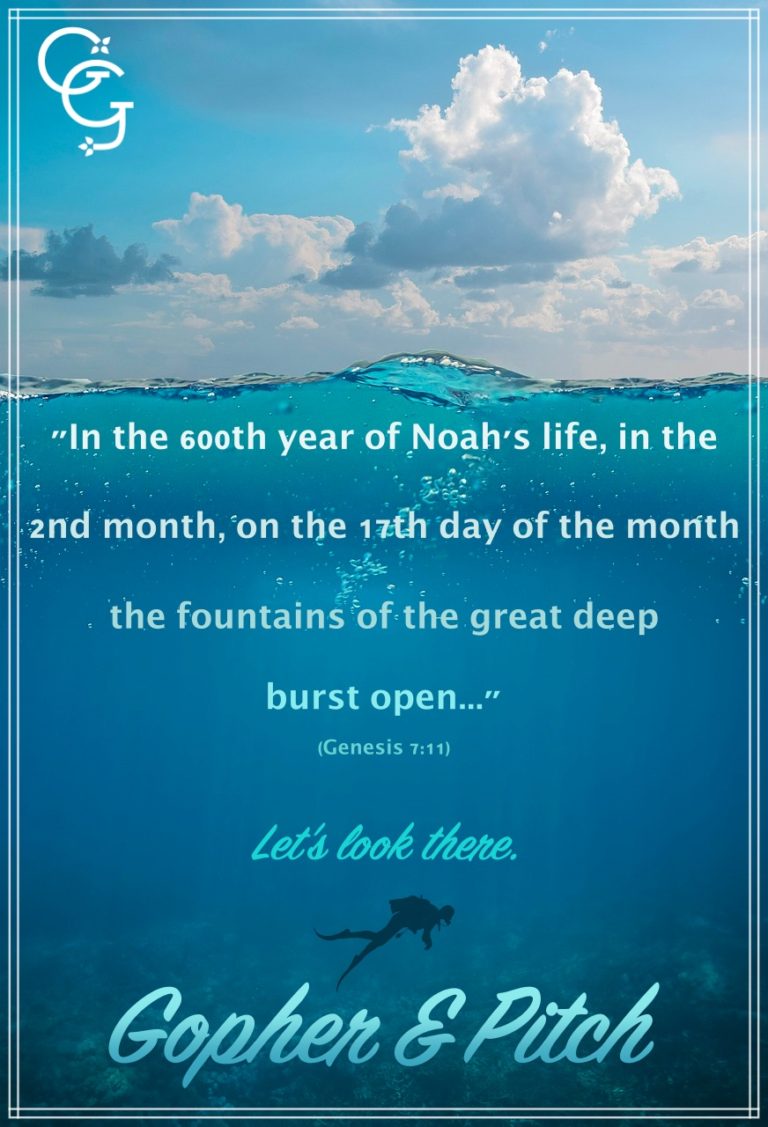In the last blog post, the roles of grace and faith in the flood account were examined. These two important theological concepts are explored extensively in the New Testament. However, in the Old Testament, while grace and faith are definitely present, they do appear a little more subtly. A bit more careful reading of the text is necessary to clearly see that not only are they indeed present but they also undergird a great deal of Scripture. As Augustine so eloquently stated, “The Old Testament is the New Testament concealed. The New Testament is the Old Testament revealed.”[1] So are there any other subtleties concealed in the Ark account? You might be surprised to hear that gopher and pitch are important.

GOPHER AND PITCH
Gopher H1613 גּפֶר “gopher” – a kind of tree or wood.[2], [3]
Pitch H3724b כֹּפֶר “kopher” – (1) pitch or tar (2) a ransom.[4]
GOPHER AND PITCH
TEXT ANALYSIS
Recognizing literary devices is one helpful tool for identifying the presence of possible deeper meanings within the biblical literature. It is interesting to note that by looking at the transliterations (gopher and kopher) it becomes apparent that the two Hebrew words rhyme. This could be a clue that the use of this specific vocabulary might possibly be a play on words or a pun with a double meaning, so a closer examination is prudent.
The word “gopher” is a specific type of tree from which Noah was to mill lumber for the construction of the ark. It occurs in the Old Testament only this one time. When a word occurs only once, it is significant. So we now know the ark was constructed from a specific wood which was unique to the flood account and not used anywhere else in Scripture.
The word “pitch” refers to tar. This substance was used to coat the inside and outside of the vessel in order to make it waterproof. The Hebrew word kopher is translated “pitch” only this one time in the Old Testament, so it too is uniquely used in the flood account. However, kopher [6] is translated “ransom” or “bribe” 13 other times in the Old Testament. In these other instances, the word takes on the meaning of “the price for a life” or a “ransom.” Furthermore, this word in verb form is kaphar which means “to cover, to make atonement, to make propitiation.”[7]
To recap, in the flood account we see that through God’s grace there is a divine plan for providing deliverance from the necessary judgement of sin for a faithful believer in the ark. This is the basic account with which most people are familiar. However, concealed a little more deeply there is specific vocabulary that is associated with the particular method of deliverance, the Ark, which includes wood, ransom and atonement. So, all together, we have the concepts of sin, judgment, death, grace, faith, and deliverance by wood, ransom, and atonement. Sound familiar?
These concepts together comprise the Gospel message. Let’s take a look at these concepts and examine their roles in the Gospel.
GOPHER AND PITCH
SIN, JUDGMENT & DEATH
We know that while Eve was deceived by the serpent, it was Adam who directly disobeyed God in the Garden of Eden (Gen 3, Romans 5:12-14). While Eve ate first and gave to Adam, the command to not eat from the Tree of the Knowledge was given by God directly to Adam. It was Adam’s disobedient eating of the fruit that allowed sin to enter the world. Adam’s sin lead to the judgment of God. God killed an animal, which would have involved blood, and covered Adam and Eve with its skin. God also pronounced judgment in the form of curses, and finally the couple was expelled from the Garden (Genesis 3).
Once that event transpired, sin and death not only entered the world but also spread to each and every one of us (Romans 5:12-14). The Apostle Paul wrote, “For all have sinned and fallen short of the glory of God” and “for the wages of sin is death” (Rom 3:23; 6:23). God in his glory is perfect and holy. Because of this fact, he must execute judgment for sin. By the time of Noah, that sinful state had consumed all of mankind. Because of sin, God again executed judgment on the world which led to the death of all except Noah and his family.
Yet none of this was a surprise to God. He knew all that would transpire before anything ever was. These judgments were a picture of his ultimate redemption solution; a solution he planned before he ever laid the foundations of the world (1 Peter 1:20).
GOPHER AND PITCH
GRACE, FAITH & DELIVERANCE
“For God so loved the world that he gave his only begotten son, that whosoever believes in him shall not perish, but have everlasting life” (John 3:16). God in his grace loved us and sent his son to pay the sin wage or penalty for us. God did this while we were stuck in the horrible sin condition and still sinning (Romans 5:8). God promises that if we will believe in his Son Jesus, then we will be delivered and pardoned from the penalty of sin. This is a gift from God as we are unable to save ourselves. It is only by placing our faith in Christ and following him that we can be forgiven. “For by grace you have been saved through faith. And this is not your own doing; it is the gift of God” (Eph 2:8). Noah received grace from God. First, he was credited with righteousness. Second, he was instructed to build an ark to deliver him from the deadly flood waters. Noah believed God and placed his faith in God’s deliverance plan by following the divine plan. In the same way, God through Christ sees us as righteous. If we place faith in him and follow, we too will be delivered.
But exactly how did Jesus pay the penalty for us and what does it have to do with the flood?
GOPHER AND PITCH
WOOD, RANSOM & ATONEMENT
Jesus, who lived a sinless life, bore our sins in his own, crucified body on the cross where his blood was shed. Like the ark that delivered Noah, the cross that delivers us was made of wood. In Scripture, the cross is sometimes referred to as “the tree” (1 Peter 2:24, Galatians 3:13; Acts 5:30; 13:29). The blood of Christ covered the wooden cross the same way the pitch covered the wooden ark. Together, these construct the mode of deliverance.
Christ offered his blood as a ransom and covering atonement for our sins (Matt 20:28; Mark 10:45; Romans 5:11). “In him we have redemption through his blood, the forgiveness of sins, in accordance with the riches of God’s grace” (Eph 1:7). The blood of Christ covered the cross, but it also covers us and cleanses us from our sin. Paul wrote, “for all have sinned and fall short of the glory of God, being justified as a gift by his grace through the redemption which is in Christ Jesus; whom God displayed publicly as a propitiation in His blood through faith” (Romans 3:23-25). As previously stated, the original Hebrew word for “pitch” carries the meaning of ransom and atonement which is the exact function of the blood of Christ in redemption.
GOPHER AND PITCH
WRAPPING IT UP
The events and specific language of Noah’s Ark paint a picture which subtly conveys the same concepts found in the Gospel message of the New Testament. While it may not be quite so obvious at first, a deeper look at gopher and pitch reveals their underlying presence. Some claim that the God of the Old Testament is different from the God of the New, but a deeper look shows that God is indeed the same. He does not change. He is the same yesterday, today and forever (Hebrews 13:8). And God, like he did for Noah, offers grace to any of us who will place our faith in him and his means of deliverance. Deliverance from sin, judgment and death comes only through grace by faith in God’s Son, Jesus Christ, whose blood was shed on a wooden cross (that tree). The blood of Christ, which covered the cross, covers and atones for us.
GOPHER AND PITCH
Read the previous article -
Treasure 1 in the Ark: Grace & Faith
Read the Ark Account
FOOTNOTES
[1] St. Augustine, Quaestiones in Heptateuchum VII 2,73: PL 34, 623; cf. DV 16.
[2] The vocabulary notations are organized in the following format: English word, Strong’s Concordance reference number(s), Hebrew word in bold, English transliteration of Hebrew word in quotes, and finally the definition.
[3] Gopher, H1613; https://biblehub.com/hebrew/1613.htm.
[4] Kopher, H3724, H3724a, and H3724b; https://biblehub.com/hebrew/3724.htm.
[5] Greek for “being said once”
[6] H3724a
[7] Kaphar H3722 and H3722a, https://biblehub.com/hebrew/3722.htm.

